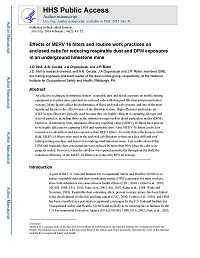Mining Publication: Effects of MERV 16 Filters and Routine Work Practices on Enclosed Cabs for Reducing Respirable Dust and DPM Exposures in an Underground Limestone Mine
Original creation date: February 2014
An effective technique to minimize miners’ respirable dust and diesel exposure on mobile mining equipment is to place mine operators in enclosed cabs with designed filtration and pressurization systems. Many factors affect the performance of these enclosed cab systems, and one of the most significant factors is the effectiveness of the filtration system. High-efficiency particulate air (HEPA)-type filters are typically used because they are highly efficient at capturing all types and sizes of particles, including those in the submicron range such as diesel particulate matter (DPM). However, in laboratory tests, minimum efficiency reporting value (MERV) 16 filters have proven to be highly efficient for capturing DPM and respirable dust. Also, MERV 16 filters can be less restrictive to cab airflow and less expensive than HEPA filters. To verify their effectiveness in the field, MERV 16 filters were used in the enclosed cab filtration system on a face drill and roof bolting mining machine and tested at an underground limestone mine. Test results showed that DPM and respirable dust concentrations were reduced by more than 90% when the cabs were properly sealed. However, when the cab door was opened periodically throughout the shift, the reduction efficiency of the MERV 16 filters was reduced to 80% on average.
Authors: JD Noll, AB Cecala, JA Organiscak, JP Rider
Peer Reviewed Journal Article - February 2014
NIOSHTIC2 Number: 20045406
Min Eng 2014 Feb; 66(2):45-52
See Also
- Clearing the Air
- Closing the Door to Dust When Adding Drill Steels: Uni-directional Cab Filtration and Pressurization System Tested
- Current NIOSH Dust Control Research for Noncoal Surface Mines
- Doing the Math: The Effectiveness of Enclosed-Cab Air-Cleaning Methods Can Be Spelled Out in Mathematical Equations
- Dust Underfoot: Enclosed Cab Floor Heaters Can Significantly Increase Operator's Respirable Dust Exposure
- The Effects of Ventilation Controls and Environmental Cabs on Diesel Particulate Matter Concentrations in Some Limestone Mines
- Laboratory and Field Evaluation of Dust Collector Bags for Reducing Dust Exposure of Roof Bolter Operators
- Maximizing Air Quality Inside Enclosed Cabs with a Unidirectional Filtration and Pressurization System
- Technology News 487 - Sweeping Compound Application Reduces Dust From Soiled Floors Within Enclosed Operator Cabs
- Technology News 533 - Minimizing Respirable Dust Exposure in Enclosed Cabs by Maintaining Cab Integrity - TN-No. 533
- Content source: National Institute for Occupational Safety and Health, Mining Program


 ShareCompartir
ShareCompartir
